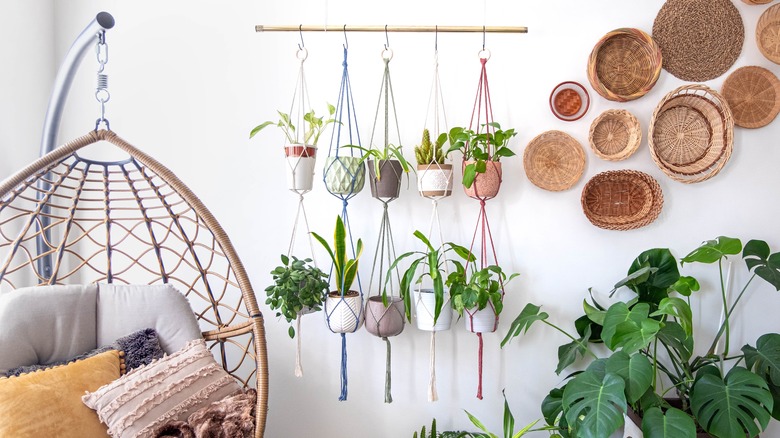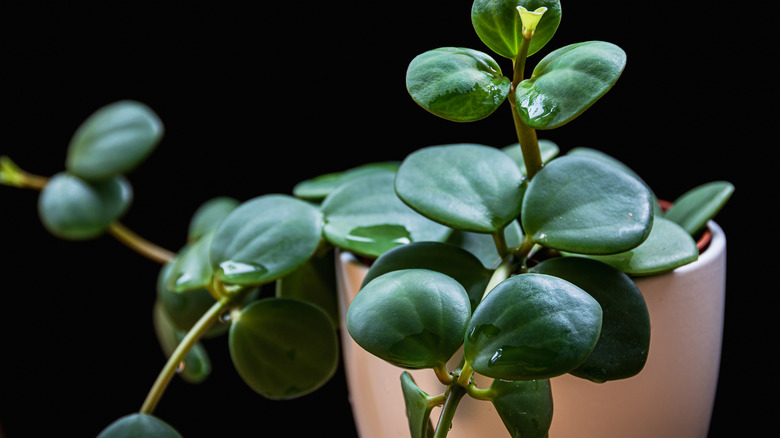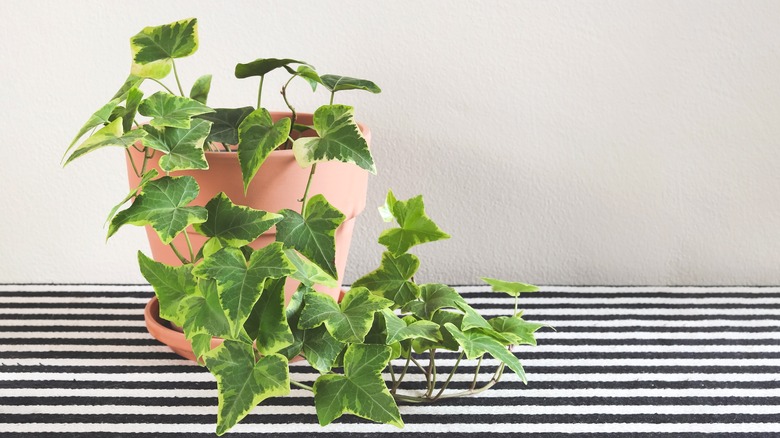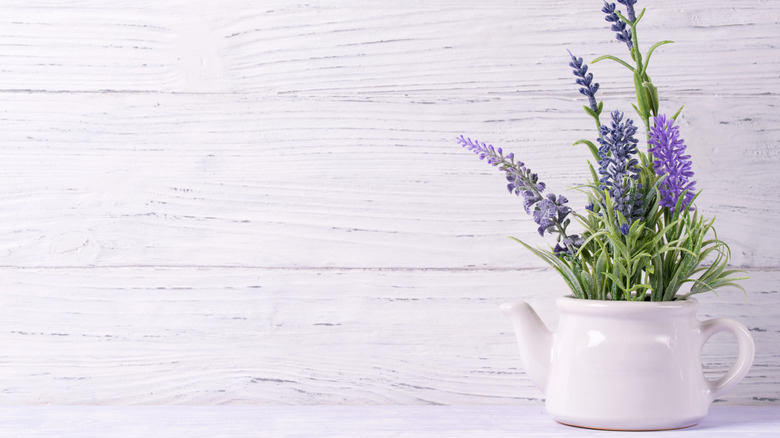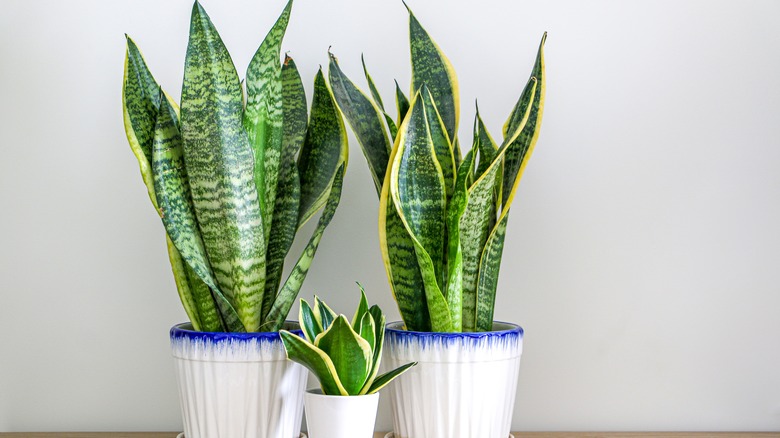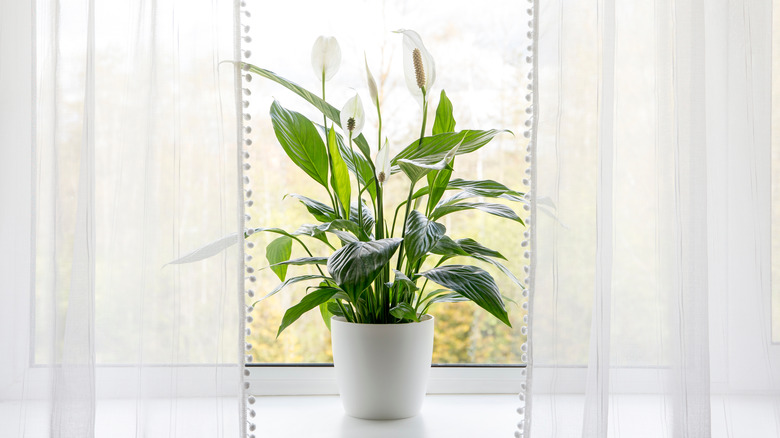5 Mood-Boosting Houseplants That'll Perk Up Any Room
Houseplants make a space look welcoming and lively, but perhaps we display them for more than just their aesthetic. Along with improving air quality, studies continually show that plants can positively affect your mind. In fact, significant data suggests that houseplants enhance concentration and productivity, reduce stress levels, and pick up your mood, NBC News writes. The simple act of repotting plants helps reduce blood pressure (via The Journal of Psychological Anthropology). "Plants also have a huge restorative capacity," Melinda Knuth, a horticultural science assistant professor at North Carolina State University, told The Washington Post. "Whether it's outdoors like in a yard or indoors with houseplants, nature can help us feel recharged and grounded."
So how do you get started? Before you begin cramming plants into your home or office, do some research on which will thrive in your space based on light, temperature, and other conditions, as well as which plants are compatible with pets and small children. The Post also notes that proximity matters. Place plants within 10 feet of where people commonly gather in a room for a more positive effect. And some studies show that different plant colors inspire different moods (via Sage Journals). Depending on the vibe you're going for, choose bright- or yellow-green plants for comfort and calmness, while dark green or red leafed-plants increase energy. White, red, pink, and purple blooms have the biggest effect on your body. Here are five mood-boosting plants to consider.
1. Vining pepper leaves
Peperomia dahlstedtii, more commonly referred to as the vining pepper plant, has a proven effect on mental and physical health. In 2015, researchers published a paper in the Journal of Physiological Anthropology that showed vining pepper leaves reduced participants' blood pressure when interacting with the plant indoors. The study noted that the simple task of replanting the foliage promoted a sense of comfort and natural feelings. Sign us up!
Luckily, vining pepper leaves are pretty easy to find and even easier to care for. According to PlantIn, vining pepper leaves originate from Central and South America. They are creeping plants that will spill over your planter once they start growing and are distinguished by a yellow veining on bright green, succulent leaves contrasted by reddish stems. These plants like lots of sunlight, and you should avoid overwatering them. Let the soil dry out between watering for a happy vining pepper plant (and a happier interior room).
2. English ivy
Another houseplant that has been shown to influence our happiness is English ivy, a vining plant with delightful heart-shaped leaves. The Washington Post references one study that reported bright and yellowish plants to have a more pleasing effect on our moods, so keep this in mind when choosing your ivy.
While ivy is usually found overtaking outdoor spaces — covering buildings and garden floors with fervor — indoors, it won't overgrow, and you can manage the plant fairly easily. Per Costa Farms, English ivy doesn't thrive in low light. If you are hanging a planter so it can cascade over the edge, find a spot with medium or even bright light. They like cooler temperatures (and humidity) and can be finicky with how much water they need. Avoid overwatering by keeping soil on the drier side, and make sure it has ample drainage. In the winter, don't let the soil dry out since it will make the plant more susceptible to pests like spider mites. Dry, browning, or fallen leaves are symptoms of a stressed-out ivy plant, so switch things up if they occur.
3. Lavender
Lavender is a popular outdoor plant, but you can also bring it inside to help lift your mood. Not only does the purple flower please the eye, but it also smells amazing when you rub it between your fingers. Fans of aromatherapy have been lauding the benefits of lavender's scent for ages, but does science actually back that up? Studies have demonstrated that lavender scent increases relaxation (per Science Daily), so you will be delighting multiple senses with this choice of houseplant. The Washington Post also notes that purple flowers have the strongest effect in lowering anxiety and increasing relaxation and mood.
Keeping your lavender happy inside will require good sunlight. Gardener's Supply Company says positioning your pot in a south-facing window (with at least 3 to 4 hours of direct sunlight) is essential. Otherwise, the flower will stop blooming, and the plant will be prone to disease. Pruning your lavender houseplant will allow new flowers to grow and will create a more robust bush. Water thoroughly, drenching the soil, and let it dry out a bit before your next watering. And if you have pets, note that this plant can be mildly toxic and should not be eaten.
4. Snake plant
Snake plants are one of the best starter plants out there because they are incredibly easy to care for. And given their deep green leaves with yellow veining, they have that mood-brightening appearance studies have found makes people happiest. Some feng shui practitioners also believe snake plants help acquire qi and provide boosts of energy, Petal Republic reports. While that may encourage a happy mood, practitioners say you should avoid placing them in rooms where you want to relax or sleep. Snake Plant Care, however, recommends keeping them in the bedroom because they produce oxygen at night, along with purifying the air.
Snake plants aren't all that picky, so they will thrive in most conditions. For optimal results, place it in a brightly lit room, but avoid direct afternoon sunlight or very low light. You don't want to overwater your snake plant, so err on the dryer side. Feel the soil to make sure it's not damp before watering — weekly or once every two weeks should do the trick.
5. Peace lily
Nothing makes a statement in a space quite like a peace lily. Along with their trademark soft folding blooms, some varieties can grow to an impressive height, giving them a real presence. With bright green leaves and a white flower, peace lilies also have the qualities studies deemed most pleasing to our mental and physical reactions to houseplants (via The Washington Post).
Peace lilies are fairly straightforward to care for at home. Lively Root says you should keep the soil moist but not drenched. The plant will begin to wilt if it needs more water. In dry conditions, mist its leaves. To find the ideal spot for your peace lily in your home, position the planter in a bright spot out of direct sunlight and dust the plant's impressive leaves regularly. In warmer months, nourishing your peace lily with a fertilizer every two months is recommended. Peace lilies are toxic if ingested, so keep this in mind if you have pets or small children.
